Inbound leads are prospects who are actively seeking solutions to their issues. The question is, is it easy for them to find you?
This is why you need result-driven inbound marketing, where you don’t chase down cold prospects. Instead, create valuable and relevant content and experiences that attract potential customers.
That said, attracting a crowd isn’t the main goal. You need a proven system to convert that inbound traffic into a predictable pipeline of qualified opportunities.
In this guide, we’ll walk through different strategies for generating inbound leads for your B2B business. We’ll also discuss how to build a solid foundation for your marketing plan and optimize every customer touchpoint for conversion.
Let’s get started.
You must develop an effective marketing plan to generate more inbound leads. Here’s how.
Inbound leads are prospects who find you through value-driven channels like content marketing, search engine optimization, or webinars. They “raise their hand” by downloading your guide, signing up for a webinar, or filling out a form.
Meanwhile, outbound leads are those that your sales team contacts directly. This is often done through email campaigns, ads, and cold calling.
For instance, let’s say your SaaS company publishes a free ROI calculator. Then, a CMO submits their email to gain access to it. That’s an inbound lead: self-initiated, interested, and already problem-aware.
Compare that to cold calling or a LinkedIn message your sales development representative (SDR) sends to the same CMO. That’s an outbound lead.
Inbound marketing only works if you’re attracting the right people. So, start by defining your ICP, which is the company you sell to.
Your ICP should specify:
Layer this with your buyer persona, which describes the individual you sell to within that company. This includes their roles, motivations, pain points, and objections.
To build your buyer persona, you can:
For example, let’s say you sell B2B email tracking software for response times. Your ICP might be mid-market SaaS companies with internal sales teams. Meanwhile, your buyer persona could be the VP of Sales who’s focused on pipeline visibility. Another could be a sales development manager, focused on lead response time.
Your inbound leads follow a journey. Since customer engagement varies at each stage, your content marketing should be tailored to guide them.

Before scaling your inbound marketing efforts, check the following assets:
You can run a content gap analysis. Compare your existing content against competitor libraries and your ICP’s top questions to understand where you need new or better inbound resources.
Also Read:
Once you have a solid foundation, it’s time to build upon it. Let’s break down different strategies for generating inbound leads.

Content helps generate inbound leads. However, random blog posts won’t cut it. You need a structured content strategy that shows authority, improves visibility, and meets your ICP where they are.
Let’s break this down.
Topic clustering and pillar pages
Search engines reward topical depth, not just scattered keywords. Here’s how it works:

Image via Typeform
This structure improves search engine optimization. It guides your readers through a clear content journey. Here’s how to build your pillar page:
Long-form vs short-form content
Both have a place in your strategy.
Long-form content (1,500+ words) includes your pillar pages, ultimate guides, and in-depth reports.
In fact, a Backlinko study confirmed that content that ranks on the first page of Google contains an average of 1,447 words. This shows that long-term content helps you reach your ideal clients.
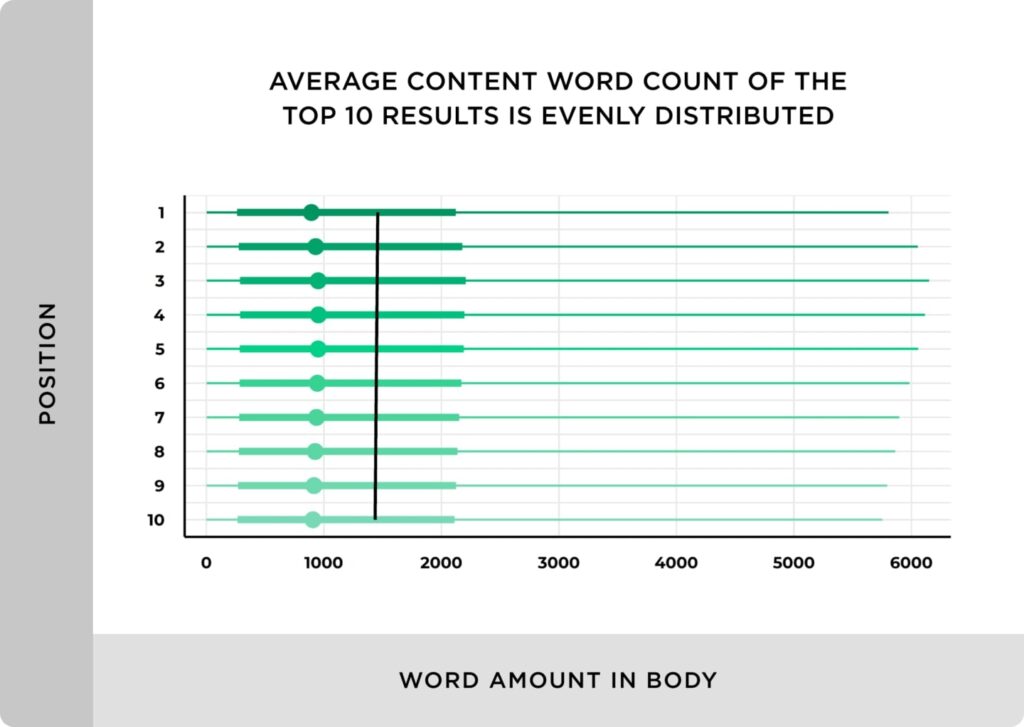
Image via Backlinko
Meanwhile, short-form content (under 1,000 words) includes blog posts that answer a specific question, social media platform updates, and email newsletters.
This style works well for driving engagement, lead nurturing, and capturing long-tail keyword searches.
Content repurposing
Creating content from scratch every time is time-consuming. Repurpose a single piece of pillar content and break it into dozens of assets.
For example, let’s say you host a webinar on email outreach strategies. Here’s how you can repurpose the content:
This ensures your message reaches audiences on their preferred platforms. You also get more inbound value from one piece of work while meeting buyers where they consume content.
Also Read:
Creating amazing content is only half the work. You need an effective SEO strategy for your business to rank for queries your ICP searches for. This way, it’s easier for inbound prospects to find your content and become high-quality leads.
Keyword research
Inbound leads start with intent. Start by understanding the language your customers use.
Find keywords with sufficient search volume that match your content’s intent. Use tools like Ahrefs or Semrush to find these keywords.

Image via Ahref
Focus on two types:
On-page best practices
Once you have a keyword, optimize your page around it. This way, search engines and readers can navigate your content easily.

Image via Google
Technical SEO
This “behind-the-scenes” work makes your site easy for search engines to read and rank.
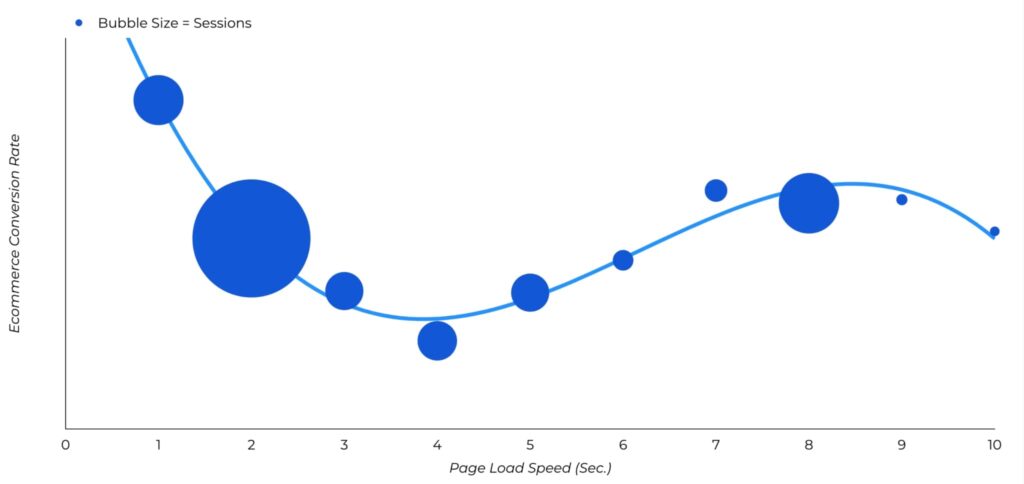
Image via Portent
Also Read:
Your SEO-optimized content builds trust and captures interest. Then, a gated offer turns that interest into a tangible inbound lead.
This is important because not every visitor is ready to talk to your sales team. However, many will happily exchange their email for valuable content that comes in the following forms.
Whitepapers, toolkits, templates, research reports
These classic, high-value B2B lead magnets solve a pressing customer problem.
Your offer must be significantly more valuable than free blog content. It should also solve a real problem your ICP faces.
Interactive tools
Static PDFs work, but interactive content delivers personalized value. It feels less like a transaction and more like practical help.
For instance, you can use calculators for ROI, cost savings, and payback period for bottom-of-funnel leads. You can even use quizzes to diagnose a problem and recommend your product as a solution.
Choose the right offer for each sales funnel stage
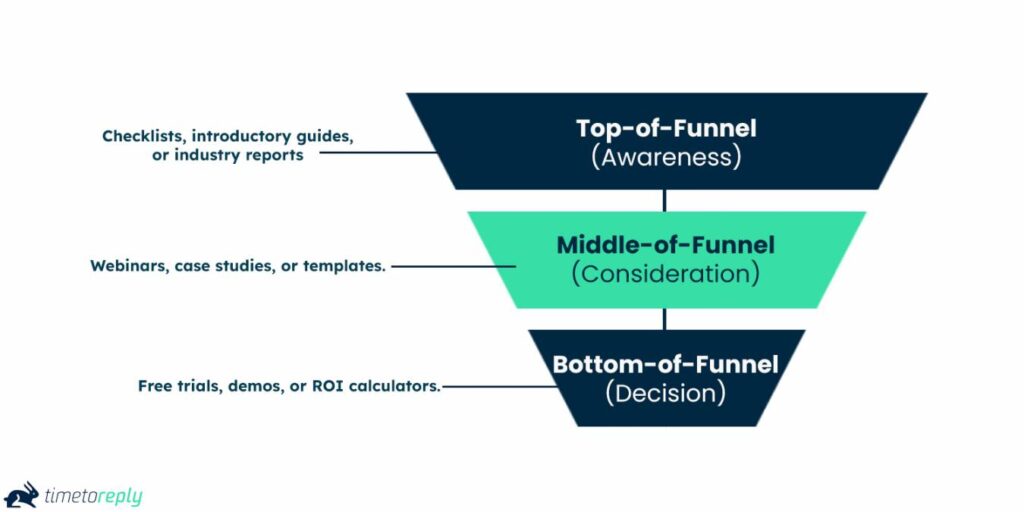
Your lead magnet should match where the prospect is in their journey.
Also Read:
Webinars and virtual events are a dynamic way to demonstrate your expertise. They help you connect with your audience in real time and capture highly qualified inbound leads. Here’s how to do it properly.
Planning, promoting, and executing
Choose a topic that addresses a major pain point for your ICP.
You can partner with an industry expert or a complementary brand to expand your reach. Then, select a reliable platform and schedule for maximum attendance.
After planning, launch registration at least 3–4 weeks in advance. Promote it across your email list, social channels, and on your website.
Then, use paid social ads to target your ideal buyer profile. Send reminder emails 24 hours and 1 hour before the event.
During the event, have a moderator and a technical host. Start on time and deliver exactly what you promised.
Engage your audience
You get the most from your live events when there’s good engagement. To engage your audience:
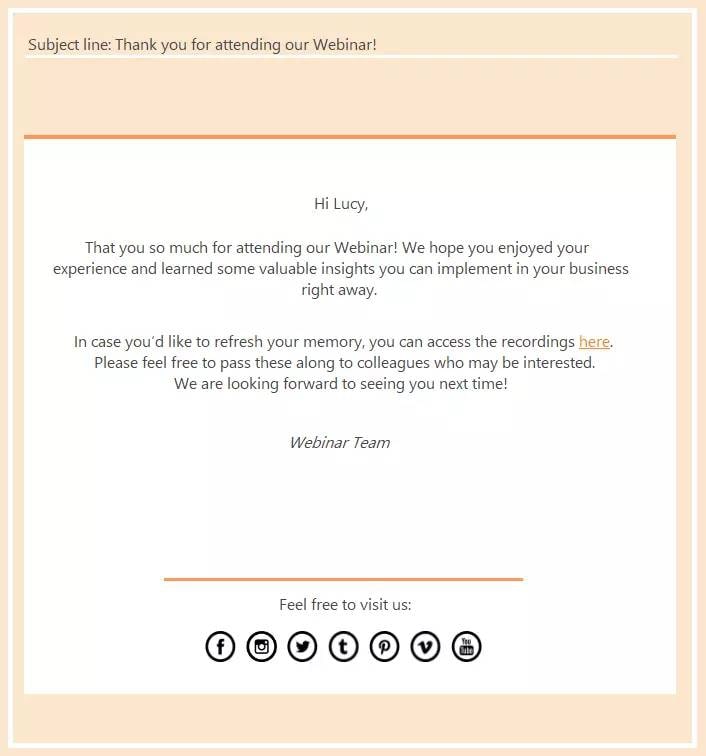
Image via LiveAgent
Convert attendees to quality leads
Registration forms capture inbound leads upfront. However, the real goal is moving them further down the sales funnel.
To do so, include a clear CTA in your follow-up email sequence. You can also offer a related consultation, free trial, or deeper-dive whitepaper.
Note the lead response time for your first follow-up. You want to strike while their interest is highest.
While you’re doing this, don’t treat all leads the same. For instance, send aggressive CTA to attendees since they engaged and are warm leads.
For registrants who are no-shows, send the recording with a “Sorry we missed you!” message.
You can use social media marketing for inbound lead generation for your B2B business. This helps you build authority and nurture customer relationships. Plus, it helps you become a top-of-mind solution to common client problems.
How B2B social differs
Your B2B social selling should be highly targeted and value-focused.
For instance, you can use LinkedIn for thought leadership, product stories, and lead gen forms. The platform gives you access to decision-makers in prospective companies.
There’s also X (formerly Twitter) for real-time industry conversations. You can engage with influencers and share quick insights with your network.
Focus on where your ICP is already having conversations.
Use employees and thought leaders to amplify reach
Your employees are your most credible ambassadors. A formal corporate post may not reach as many as when an employee shares it.
Encourage your team, especially subject matter experts, to share company content with their own insights.
This humanizes your brand and expands your organic reach. It also turns your entire workforce into an inbound lead generation tool.
Use LinkedIn articles, newsletters, and micro-content
LinkedIn now supports in-app content. You can use a mix of content to keep prospects engaged without leaving the platform.
Use articles and newsletters to establish authority on a topic. They’re perfect for long-form content and building a subscribed audience.
There’s also micro-content, such as posts, carousels, and short videos. You can use it to share a quick tip, a data point from a report, or a key slide.
Also Read:
Sometimes, the fastest way to attract more inbound leads is by tapping into someone else’s audience.
Guest publishing and co-marketing bring your brand to a new, highly relevant pool of potential inbound leads. A good example is QuickBooks’ partnership with GIPHY and Danny Devito.
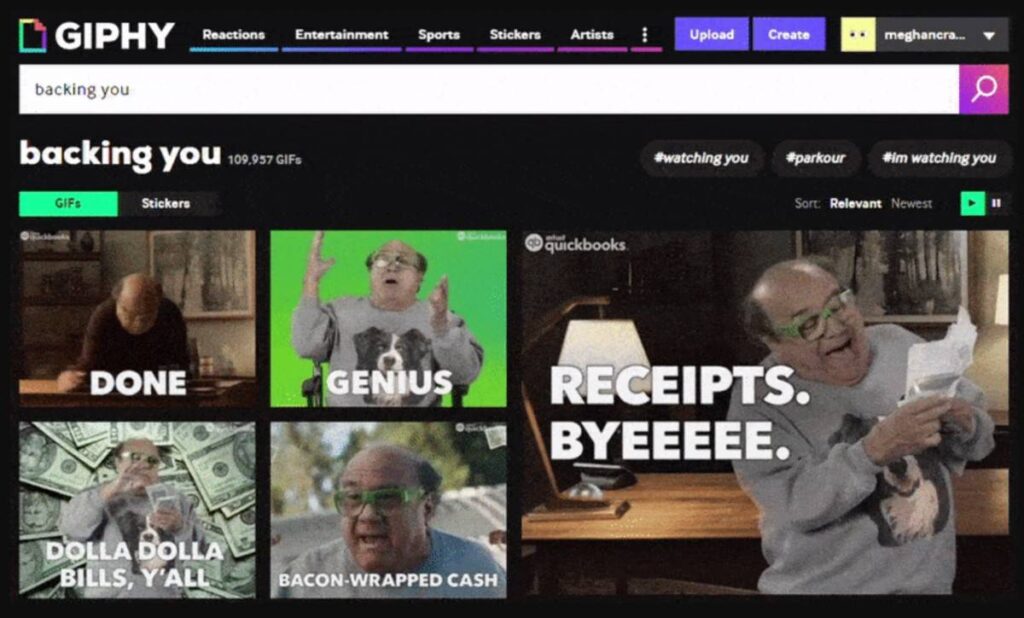
Image via Giphy
Publish on industry blogs and partner sites
Writing for established industry publications lets you tap into their authority and boost your credibility.
Plus, it drives targeted referral traffic and builds high-quality backlinks for SEO.
To start:
Use co-hosted webinars and joint content
Partner with non-competing brands that serve the same customer profile. This lets you double your reach while sharing the workload. For example, if you’re a CRM company, you can partner with a sales training firm.
For effective co-marketing, you can use:
Negotiate, promote, and share credit
A successful partnership is built on clarity. This is why you must define goals, responsibilities, and deliverables upfront. You should also decide how you will measure success.
Additionally, parties involved must promote equally across all channels, including email, social, and website. You can use a shared promotional calendar to track this.
You can also use a shared tracking link or a dedicated landing page to attribute inbound leads fairly.
Paid doesn’t have to mean outbound marketing. Plus, paid channels don’t replace your organic ones.
When used correctly, paid campaigns can boost your inbound leads. The key is using them to promote valuable content, not just a “buy now” message.
Use paid search/PPC to promote gated content
Instead of just bidding on product keywords, run PPC campaigns for your lead magnets.
Google Ads and Bing search campaigns can help drive inbound traffic to your whitepapers, toolkits, or calculators, effectively capturing leads.
Here’s how it works:
Implement social ads
You can use LinkedIn lead gen forms. Here, users submit their details to download your content without leaving LinkedIn, thereby reducing friction.
You can also use Meta and X ads to promote gated content to a targeted audience based on their job titles, interests, and behaviors.
Retarget people who visited but didn’t convert
Website visitors who didn’t convert are warm leads that you should take advantage of. You can:
Align paid efforts for inbound rather than outbound
To keep your paid channels focused on generating inbound leads:
Also Read:
To consistently generate more inbound leads, you must measure performance, learn from it, and double down on what works. How do you do this?
Focus on the marketing KPIs that directly tie to revenue and efficiency. This includes:
Your lead data only works if it’s visible and actionable. Use dashboards to track campaigns across channels. You can use the following tools:
You should also create a simple dashboard that displays your key KPIs. This gives your team a single source of data.
Inbound leads often have multiple touchpoints. Attribution assigns credit to each interaction, so you can identify which channel drove the lead. You can use the following models:
Also Read:
1. What is the difference between inbound leads and outbound leads?
Inbound leads come to you through content, SEO, or events; they’re typically warmer and more sales-ready. Outbound leads are contacted directly via cold calls or outreach.
2. Which inbound channels deliver the highest ROI for B2B companies?
Content marketing, SEO, and targeted webinars typically deliver the highest ROI for B2B companies. These channels focus on attracting and engaging a specific, high-intent audience that’s actively seeking solutions.
3. How can inbound leads be qualified effectively?
Use a lead scoring system to qualify your inbound leads. Assign points for specific demographic details, such as job title or company size, and for engagement behaviors, such as visiting pricing pages or downloading a case study.
This objective data separates interested prospects from casual visitors.
4. What tools or platforms are essential for inbound lead management?
You can use a robust CRM, like HubSpot or Salesforce, to track all prospect interactions. Integrate this with an inbound marketing automation platform for email and lead nurturing, along with a dedicated analytics tool.
Moreover, you can incorporate an email tracking solution like timetoreply. This provides real-time visibility into lead engagement and team response performance, ensuring no opportunity is missed and follow-ups are optimally timed.
5. What’s the most common mistake companies make with inbound leads?
The most common mistake is failing to follow up promptly and effectively. Inbound marketing generates the lead, but a slow or generic response from your sales team can ruin the opportunity.
So, set a clear process for immediate, personalized engagement, and use reliable tools like timetoreply to track follow-up performance.
6. How often should inbound marketing content be updated?
Google prioritizes fresh, relevant content. For SEO, update high-performing blog posts and pillar pages every 6-12 months. Refresh statistics, add new sections, and ensure information is always up to date. For gated assets like ebooks, a yearly review is enough.
7. Do inbound leads always cost less than outbound leads?
While inbound leads generally have a lower cost per lead over time, you may need to invest significantly in content and SEO at first. Meanwhile, outbound marketing can sometimes achieve faster results for specific campaigns.
8. How can you improve the quality of inbound leads?
Improve your ideal customer profile (ICP) and create content that speaks directly to their specific pains, not general topics. You can use middle-of-funnel offers, like case studies and webinars, to attract serious buyers.
Generating inbound leads consistently is a systematic process. It starts with defining your ICP and customer journey, building a pillar-based content strategy, and optimizing every touchpoint for conversion.
Amplify your best assets and nurture leads with targeted automation. Then, constantly measure and iterate.
Are you ready to stop chasing and start converting? Start by understanding your team’s current lead response performance. Sign up for a free timetoreply trial today and ensure no inbound lead ever slips through the cracks.
Get live inbox alerts and reply quickly to customer emails with timetoreply